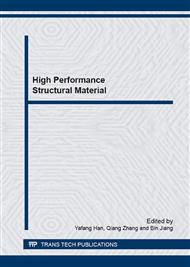p.48
p.54
p.64
p.71
p.78
p.84
p.91
p.96
p.102
Influences of High Temperature Treatment of C/C on the Mechanical Properties of C/C-SiC Composites
Abstract:
C/C-SiC composite as low expansion material for space opto-mechanical structures was prepared by gaseous silicon infiltration after high temperature treatment (HTT) on C/C. 2000°C and 2400°C were selected as the treatment temperatures for C/C to study the influences on the properties of C/C-SiC composite. The graphitization level of amorphous C in C/C was improved by HTT. The porosity of C/C increased from 32.88% to 34.25% (2000°C) and 41.06% (2400°C) respectively. In addition, a higher HTT temperature led to a higher density of C/C-SiC composite and a lower SiC content. Furthermore, the mechanical properties and coefficient of thermal expansion (CTE) of the composite decreased as the temperature increased. After 2000°C HTT, the CTE of C/C-SiC composite decreased to-0.055×10-6·K-1 and the mechanical properties (218 MPa) could meet the application demand at the same time.
Info:
Periodical:
Pages:
78-83
Citation:
Online since:
April 2015
Authors:
Price:
Сopyright:
© 2015 Trans Tech Publications Ltd. All Rights Reserved
Share:
Citation:


